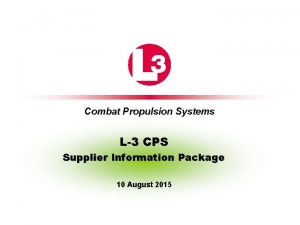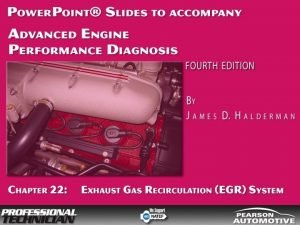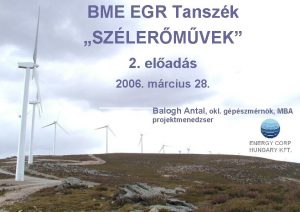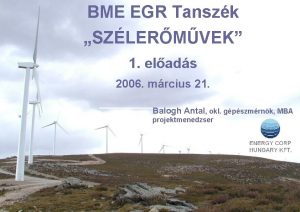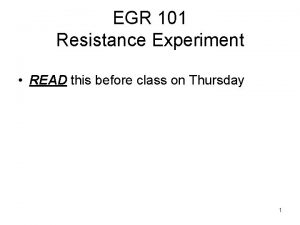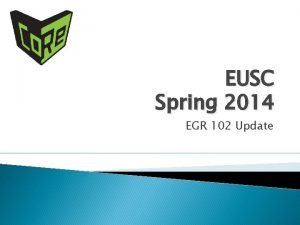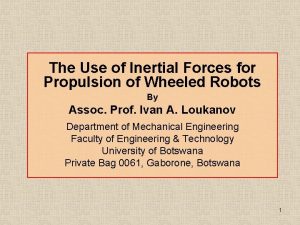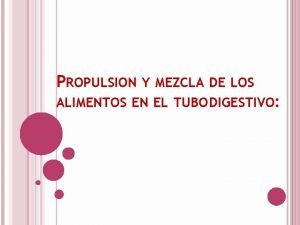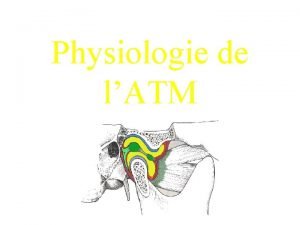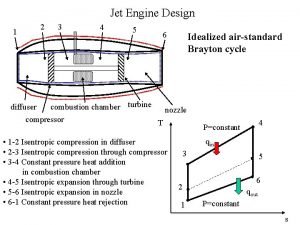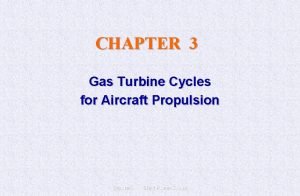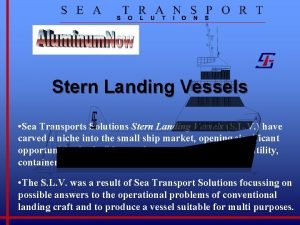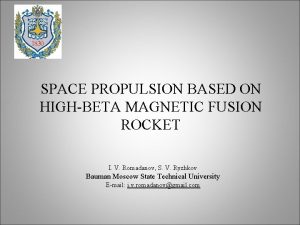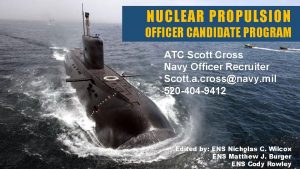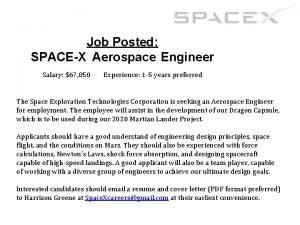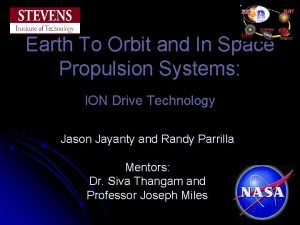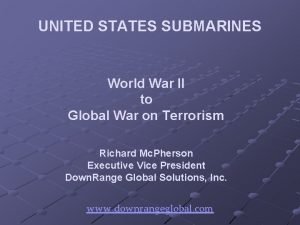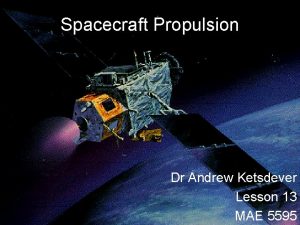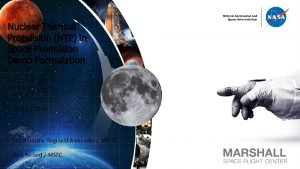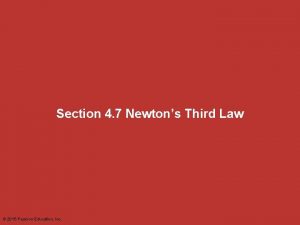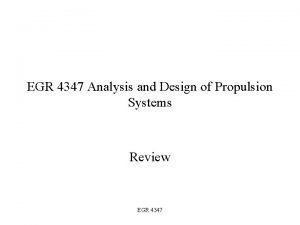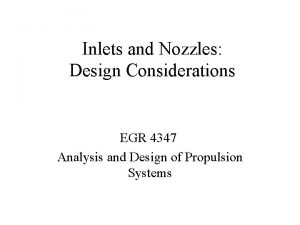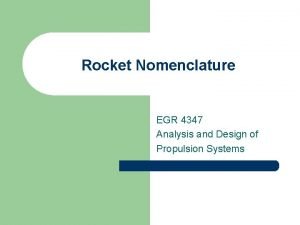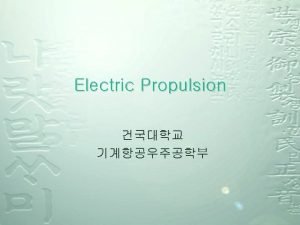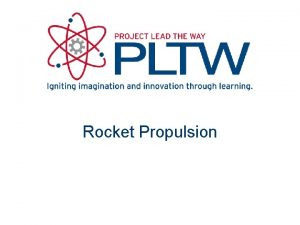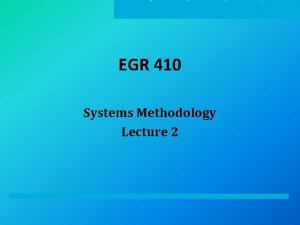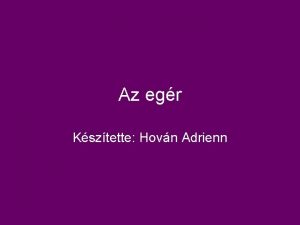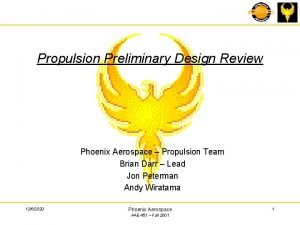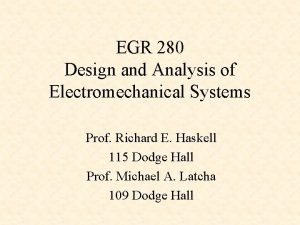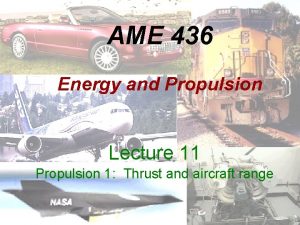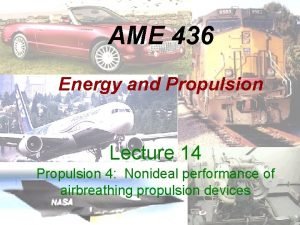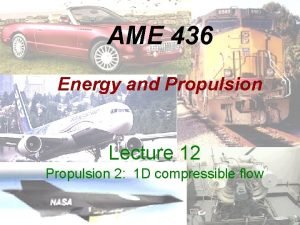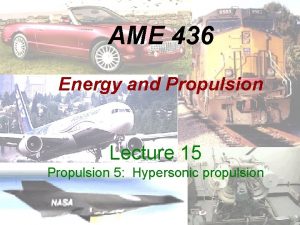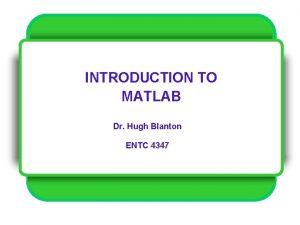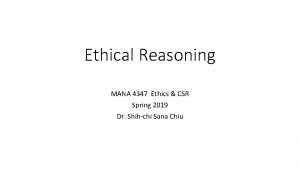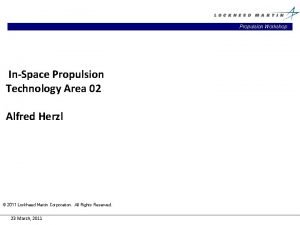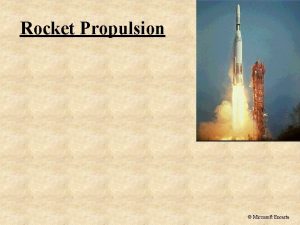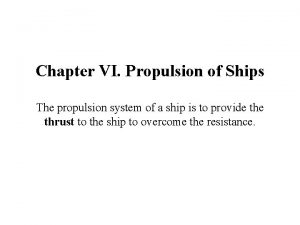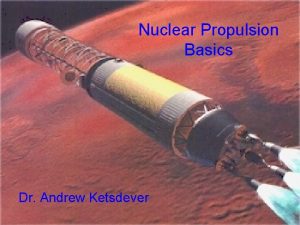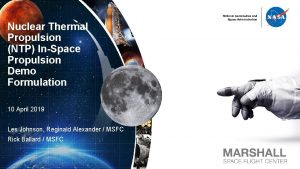EGR 4347 Analysis and Design of Propulsion Systems



































- Slides: 35

EGR 4347 - Analysis and Design of Propulsion Systems Dr. Ken Van Treuren Department of Engineering Baylor University 1 Thanks to USAFA and USAF Test Pilot School Propulsion

BEGINNINGS Date: 17 December 1903 Location: Kitty Hawk, North Carolina 2 Thanks to USAFA and USAF Test Pilot School Propulsion

Faster -- Higher -- Farther 3 Thanks to USAFA and USAF Test Pilot School Propulsion

Prevailing Thoughts “In its present state, and even considering the improvements possible in adopting the higher temperatures proposed for the immediate future, the gas turbine could hardly be considered a feasible application of airplanes, mainly because of the difficulty in complying with the stringent weight requirements imposed by aeronautics. ” National Academy of Sciences - Late 1930’s 4 Thanks to USAFA and USAF Test Pilot School Propulsion

Sir Frank Whittle (1941) W. 1 Gloster E 28/29 Experimental Aircraft 5 Thanks to USAFA and USAF Test Pilot School Propulsion

Hans von Ohain (1937) He. S 3 B He 178 6 Thanks to USAFA and USAF Test Pilot School Propulsion

1940’s Jumo 004 World’s 1 st mass produced turbojet http: //www. soton. ac. uk/~aeroastr/4 projects/Genesis/Level 2/Engines/Jumo 4. htm ME 262 http: //www. iag. net/~emccann/models/me 262 rec. htm 7 Thanks to USAFA and USAF Test Pilot School Propulsion

1950’s J-79 http: //www. seattleu. edu/~jmatt/pictures/J 79. gif F-4 E http: //www. wpafb. af. mil/museum/research/fighter/f 4 e-18. jpg 8 Thanks to USAFA and USAF Test Pilot School Propulsion

1960’s TF-39 http: //www. seattleu. edu/~jmatt/pictures/TF 39. gif C 5 A http: //www. primenet. com/~gbe/Midway/C 5 A_Galaxy. htm 9 Thanks to USAFA and USAF Test Pilot School Propulsion

1970’s F 100 F-15 http: //www. wpafb. af. mil/museum/modern_flight/mf 21 b. htm 10 Thanks to USAFA and USAF Test Pilot School Propulsion

1980’s-1990’s F-119 F-22 11 Thanks to USAFA and USAF Test Pilot School Propulsion

1990’s - 2000’s YF-120, with axisymmetric vectoring nozzle http: //www. aeroworldnet. com/fth 15. htm JSF 12 Thanks to USAFA and USAF Test Pilot School Propulsion

2002+ X-43, Hypersonic Research Vehicle Predator, Medium Altitude Endurance UAV http: //www. fas. org/irp/agency/daro/uav 95/gifs/predcomp. gif Uninhabited Combat Air Vehicle (UCAV) http: //popularmechanics. com/popmech/sci/tech/9709 TUMIAM. html Global Hawk, High-Alt Long Endurance Aerial Recon UAV http: //defenselink. dtic. mil/photos/Feb 1997/970220 -D-0000 G-001. html 13 Dark Star, LO High Endurance UAV http: //www. fas. org/irp/program/collect/darkstar. htm Thanks to USAFA and USAF Test Pilot School Propulsion

2002+ Space Launch Initiative (SLI) Airbus A-380 Aviation Week & Space Technology, April 1, 2002, p 28 Aerospace Engineering, March 2001, p 7 Boeing Sonic Cruiser B-X Supersonic “Quiet” Bomber 14 Aviation Week & Space Technology, May 6, 2002, p 28 M 400 Skycar Aviation Week & Space Technology, April 15, 2002, p 69 Mechanical Engineering, May 2001, p 96 Thanks to USAFA and USAF Test Pilot School Propulsion

15 Thanks to USAFA and USAF Test Pilot School Propulsion

Basic Turbine Engine Components Compressor 16 Turbine Combustor Nozzle Thanks to USAFA and USAF Test Pilot School Propulsion

Turbojet • Advantages – – Few Moving Parts Large Operating Envelope Static Thrust Small Frontal Area • Disadvantages – – – Large Number of Parts Expensive Low Thrust at Low Mach High noise High TSFC • Application - broad range J-79 – Small Mass to High Velocity 17 Thanks to USAFA and USAF Test Pilot School Propulsion

Turbojet - Applications SR-71 Harpoon (TJ+solid fuel booster) Concorde 18 F-4 Thanks to USAFA and USAF Test Pilot School Propulsion

Low Bypass Ratio Turbofan • • Advantages – Few Moving Parts – Large Operating Envelope – More Static Thrust – Better Subsonic TSFC – FOD protection of HPC – Large Afterburner Possible – Low Noise Disadvantages – – – • 19 Large Number of Parts Expensive Medium Frontal Area Engine Response Air Start Application - medium mass to medium velocity F 100 Thanks to USAFA and USAF Test Pilot School Propulsion

Low Bypass Ratio Turbofan - Applications YF-22 Tomahawk Cruise Missile UCAV 20 JSF Thanks to USAFA and USAF Test Pilot School Propulsion

High Bypass Ratio Turbofan GE-90 21 Thanks to USAFA and USAF Test Pilot School Propulsion

High Bypass Ratio Turbofan - Applications A-10 KC-10 C-5 A 777 22 Thanks to USAFA and USAF Test Pilot School Propulsion

Turboprop/Turboshaft T-800 • Advantages – – – – Few Moving Parts Large Operating Envelope Best Static Thrust Best Low Subsonic TSFC Constant RPM Possible Low Noise Propeller Reverse • Disadvantages – – – Large Number of Parts Expensive Complex Gearbox Large Frontal Area Propeller Governor • Application - Low Mach (Large mass to low velocity) 23 T-56 Thanks to USAFA and USAF Test Pilot School Propulsion

Turboprop/Turboshaft - Applications Saab 2000 C-130 V-22 RAH-66 Comanche 24 Thanks to USAFA and USAF Test Pilot School Propulsion

Ramjet/SCRAMjet • Advantages – – No moving parts Simple Inexpensive Small frontal area Liquid Propellant Ramjet Solid Fuel Ramrocket at Launch - Rocket Mode • Disadvantages – No accessory drive – Optimized for design condition – No static thrust • Application High Mach – Bomarc missle – Future missles 25 SCRAMjet (Strut. Jet) Thanks to USAFA and USAF Test Pilot School Propulsion

Ramjet/SCRAMjet - Applications Fasthawk Hyper -X Bomarc D-21 Drone Hypersoar 26 Thanks to USAFA and USAF Test Pilot School Propulsion

Principles of Jet Propulsion - Engine Performance Installed Performance Thrust, T Thrust Specific Fuel Consumption, Uninstalled Performance Thrust, F Thrust Specific Fuel Consumption, Installation losses Inlet Drag, Dinlet Nozzle Drag, Dnozzle Relationships T = F - Dinlet - Dnozzle = F(1 -finlet - fnozzle) TSFC = S/ (1 -finlet - fnozzle) 27 Thanks to USAFA and USAF Test Pilot School Propulsion

Principles of Jet Propulsion - THRUST Direction of Movement Escaping Air Opposite force causes the balloon to move 28 Forces removed by opening the stem Thanks to USAFA and USAF Test Pilot School Propulsion

Principles of Jet Propulsion - THRUST ma F= gc 1 d. M 1 d(m. V) SF= = gc dt Note: Momentum = M = m. V Force = mass x acceleration Fn = m (Vj - Va) + Aj (Pj - Patm) gc Net thrust = change in momentum + pressure force at exit 29 Thrust is therefore produced when air exits the engine faster than when it entered. Thanks to USAFA and USAF Test Pilot School Propulsion

Principles of Jet Propulsion - THRUST From a thermodynamic perspective, the engine’s job is to convert chemical energy of the fuel into kinetic energy of the air passing through the engine. The following engine components enable this energy conversion and determine the efficiency at which this conversion takes place: INLET - Converts kinetic energy of entering air into a pressure rise by decelerating the flow COMPRESSOR - Increases air pressure to increase combustion cycle efficiency COMBUSTOR - Add chemical energy to the air to provide power to the turbine and to produce desired thrust TURBINE - Extracts energy from the hot gases to drive the compressor and aircraft accessories EXHAUST DUCT AND NOZZLE - Collects, straightens, and accelerates the air 30 Thanks to USAFA and USAF Test Pilot School Propulsion

Basic Turbine Engine Components Schematic & Numbering Gas generator Inlet 0 Low-pressure compressor 1 Highpressure compr 2. 5 3 H L Combustor P P T T 4 4. 5 5 Nozzle 8 HPT = High-pressure turbine LPT = Low-pressure turbine 31 Thanks to USAFA and USAF Test Pilot School Propulsion

Static Temperature and Pressure Variations Through Engine Static Temperature (R) 350 300 250 200 Static Pressure (psia) 150 100 50 0 32 Thanks to USAFA and USAF Test Pilot School Propulsion

Engine Types m F g (Ve - Vi) c Turbojet - large velocity change Low Bypass Ratio Turbofan - large velocity change & increased mass flow High Bypass Ratio Turbofan - very large mass flow & small velocity increases Turboprop - energy extracted by a low pressure turbine drives a gear box which runs a prop. Large mass flow, very small velocity change through prop Turboshaft (similar to turboprop) - runs a rotor or power producing shaft Ramjet - M>1 applications, large mass flow & small velocity increase SCRAMjet - M>5 applications, very large mass flow & small velocity increase 33 Thanks to USAFA and USAF Test Pilot School Propulsion

Engine Performance Characteristics 34 Thanks to USAFA and USAF Test Pilot School Propulsion

Engine Performance Characteristics 35 Thanks to USAFA and USAF Test Pilot School Propulsion
 L3 cps
L3 cps Two technicians are discussing back pressure
Two technicians are discussing back pressure Bme egr
Bme egr Bme egr
Bme egr Egr 101
Egr 101 Egr 102
Egr 102 Inertial propulsion drive
Inertial propulsion drive Propulsión en el sistema digestivo
Propulsión en el sistema digestivo Diagramme de posselt dans le plan sagittal
Diagramme de posselt dans le plan sagittal Jet engine diffuser
Jet engine diffuser Propulsion efficiency
Propulsion efficiency Stern of a vessel
Stern of a vessel Magnetic space propulsion
Magnetic space propulsion Nuclear propulsion officer candidate program
Nuclear propulsion officer candidate program Spacex starting salary
Spacex starting salary Siva de scalzo
Siva de scalzo Nuclear propulsion
Nuclear propulsion Propellantless propulsion
Propellantless propulsion Nuclear thermal propulsion
Nuclear thermal propulsion 10 year old sarah stands on a skateboard
10 year old sarah stands on a skateboard Systems analysis and design kendall and kendall
Systems analysis and design kendall and kendall Systems analysis and design in an age of options
Systems analysis and design in an age of options Gantt chart system analysis and design
Gantt chart system analysis and design Systems analysis and design in a changing world
Systems analysis and design in a changing world System analysis and design in a changing world
System analysis and design in a changing world System analysis and design alan dennis
System analysis and design alan dennis Introduction of system analysis and design
Introduction of system analysis and design Structured systems analysis and design methodology
Structured systems analysis and design methodology Modern system analysis and design
Modern system analysis and design Modern systems analysis and design
Modern systems analysis and design Kendall & kendall systems analysis and design
Kendall & kendall systems analysis and design System analysis and design dennis
System analysis and design dennis Systems analysis and design alan dennis
Systems analysis and design alan dennis Systems analysis and design alan dennis
Systems analysis and design alan dennis Systems analysis and design alan dennis
Systems analysis and design alan dennis Systems analysis and design alan dennis
Systems analysis and design alan dennis
